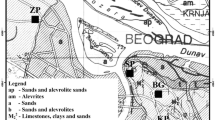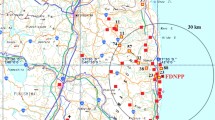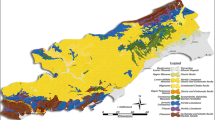Abstract
In this study, soil samples were collected at Canadian embassy in Tokyo (about 300 km from Fukushima) on 23 March and 23 May of 2011 for purposes of estimating concentrations of radionuclides in fallout, the total fallout inventory, the depth distribution of radionuclide of interest and the elevated ambient gamma dose-rate at this limited location. Some fission products and actinides were analyzed using gamma-ray spectrometry, alpha spectrometry and liquid scintillation counting. The elevated activity concentration levels of 131I, 132I, 134Cs, 137Cs, 136Cs, 132Te, 129mTe, 129Te, 140Ba and 140La were measured by the gamma-ray spectrometer in the first sample collected on 23 March. Two months after the accident, the 134Cs and 137Cs became only detectable nuclides. A mass relaxation depth of 3.0 g/cm2 was determined by the activities on the depth distribution of 137Cs in a soil core. The total fallout inventory was thus calculated as 225 kBq/m2 on March sampling date and 25 kBq/m2 on May sampling date. The ambient gamma dose-rates in the sampling area estimated by the fallout fission products inventory and 137Cs depth distribution ranged from 184 to 38 nGy/h. There was no detectable americium or plutonium in the soil samples by alpha spectrometry. Although 90Sr or 89Sr were detected supposedly as a result of this accident, it was less than the detection limit, which was about 0.4 Bq/kg in the soil samples.
Similar content being viewed by others
Explore related subjects
Discover the latest articles, news and stories from top researchers in related subjects.Avoid common mistakes on your manuscript.
Introduction
The Fukushima nuclear accident on March 11th, 2011 released large amounts of radioactive material in the environment, which raises great concerns over the ambient gamma dose-rate and isotope concentrations in residential soils. For ensuring the safety of Canadians at abroad, Health Canada deployed two NaI(Tl) detectors to the Canadian embassy in Tokyo. The detectors have been calibrated for ambient dose-rate following the procedures described by Grasty et al. [1]. In the procedures, the calibration coefficients in a particular energy region of the spectrum were experimentally determined using certified standard radionuclide sources with known activities and gamma-ray emission rates. The total ambient gamma dose-rate can then be calculated by integrating the product of the energy deposited in each specific energy region and the calibration coefficient corresponding to that energy region over the spectrum. It is of interest to apply the calibrated detector for an on-site ambient gamma dose-rate measurement within the fission product contaminated landscape. The atmospheric fallout fission products provide an opportunity to establish on-site cross-calibration to further verify these coefficients by the location specifically measured soil inventories of fallout fission products and the depth distributions of 137Cs.
For the fallout fission products analysis and detector ambient gamma dose-rate cross-calibration purposes, surface soil samples were collected at the Canadian embassy gardens in Tokyo, where a NaI(Tl) detector was installed, as shown in Fig. 1, to measure absorbed ambient dose-rate 1 m above the ground level. The samples were shipped to radioanalytical laboratories for alpha-, beta- and gamma-emitters analysis as part of an environment radioactive monitoring programme at Radiation Protection Bureau, Health Canada. One sample was collected in the initial period of the accident, which was on March 23rd just after two rainfalls that caused deposition and increased the ambient dose-rate. The other one was taken on May 23rd, 2 months from the initial accident, to monitor nuclide inventory variations in the soil. The paper presents the results of the measurement of gamma-emitter contaminations in both soil samples. The potential contaminations from alpha- and beta-emitters were also investigated in the soil sample collected on March 23rd using alpha-spectrometry and liquid scintillation counting. The NaI(Tl) detector cross-calibration results will be published in a separate paper [2].
Materials and methods
The soil sampling and gamma spectrometry analysis
The soil samples were collected as a rectangular shaped 20 × 20 cm piece and to the depth of 5 cm, which is sufficient to include all activity that has penetrated the soil, and uniform cross-sectional area as the United Nations Scientific Committee on the Effects of Atomic Radiation (UNSCEAR) has proposed a relaxation depth of l.0 cm through the first year and 3.0 cm thereafter based on the fallout studies about the Chernobyl accident [3]. It should be noted that the March 23rd sample was collected from a spot that is a grassless and sand landscape. While the other sample was collected from a different spot that is a grass-covered lawn. The top vegetation part (about 2 cm) of the second sample was removed from bottom soil part and shipped to the laboratory as a separated sample for analysis. A core garden soil sample (0–10 cm) was collected on the same spot using a 3 cm diameter tube. The soil core was sliced into 2.5 cm thick slices. The 137Cs activity of each slice was determined using the HPGe detector. The activities on the depth distribution of 137Cs in the soil core are plotted in Fig. 2. The exponentially fitted curve, as shown in the figure, was used to assess the soil relaxation depths of 137Cs. Based on the measurement results and the bulk density of the garden soil, a mass relaxation depth of 3.0 g/cm2 was estimated.
In the laboratory, all samples were air dried about 3 days in a fume hood, then crushed and homogenized as well as possible. Evidence suggests that such air-dry procedure cannot result in any significant iodine loss in the sample [4]. The large stones were removed before the samples were weighed (about 150 g) and sealed in a plastic jar for analysis. The jar is cylinder-shaped (60 mm-diam × 55 mm-height) PVC vial. These vials were then counted on the top of a calibrated HPGe detector for the gamma-spectrum acquisition. The HPGe detector used in this study was an Ortec n-type GMX coaxial detector with a crystal diameter of 6.62 cm and a length of 6.90 cm. This detector had a relative efficiency of 25 % with respect to a standard NaI(Tl) detector at 1,332.5 keV of 60Co, and a resolution (FWHM) of 0.85 keV at 122.1 keV peak of 57Co. The detector endcap was made entirely of carbon fiber to meet the high radiation transmission requirement. A semi-empirical full energy peak (FEP) efficiency calibration protocol was developed for this counting geometry to properly quantify radionuclide activity in samples [5]. This model combines both experimental measurements and Monte Carlo (MC) simulations, taking into consideration the soil bulk density and its chemical composition. The mathematical calibration software tool for MC simulation is Virtual Gamma Spectroscopy Laboratory (VGSL) [6]. With the empirically validated detector model and soil sample geometry as inputs, the FEP efficiencies for photons between 30 and 2,000 keV were simulated by VGSL. An IAEA soil reference material (IAEA-375), with known amounts of 40K, 134Cs, 137Cs activity concentration and elemental composition, was selected to test the FEP simulation. In the case of nuclides decay by cascading photons, for example 134Cs, losses by sum coincidences were taken into account. The results obtained for the reference material all fall within the 95 % confidence interval of the certified mean values.
The sample processing and alpha spectrometry and liquid scintillation counting
One gram sub-samples were taken and dissolved with mineral acids. No filtering or sieving was done prior to dissolution. The actinides were separated from the resulting solution by the use of Eichrom resins using 242Pu, 233U and 243Am as chemical yield tracers. The isolated actinides were then electrodeposited and counted for 3 days. Strontium was isolated from the dissolved soil by the use of Eichrom Sr resin. The separation was done three times to remove all other beta activity from the sample. A small fraction of the isolated strontium fraction was taken for chemical yielding by ICP/OES, and the remaining fraction was counted by LSC for 100 min. In all cases, the samples were run in quadruplicate.
Results and discussions
The nuclide specific analysis of the March 23rd collected soil sample showed the deposition of 131I, 132I, 134Cs, 137Cs, 136Cs, 132Te, 129Te, 129mTe, 140Ba and 140La respectively. Their activity mass concentrations were measured and summarized in Table 1. The source strength in the form of an inventory, i.e. activity per unit area (kBq/m2), is also presented in the table. A bulk density of 0.85 g/cm3 was determined by the collected top garden soil. The activity mass concentration in the sample multiplied by the bulk density and sampling depth would be the value of the inventory. The radionuclide inventory and absorbed ambient dose-rates (nGy/h) from the given inventory were calculated using the estimated mass relaxation per unit area, as discussed above. The results are also listed in the table. The above ground ambient dose-rate conversion factors used for calculation were taken from the literature, which is ideally for level grassland or lawn terrain [7, 8]. As listed in Table 1, in the first few weeks of the accident, the 131I and 132I played a major role in the ambient dose-rate contributions (with about 76 % of total), then followed by 140La (7 %) and 134Cs (5 %). The ambient dose-rate calculations according to soil sample analysis agrees very well with the results of field NaI(Tl) spectrometric method, as presented in Table 1. It is interesting to note that the activity mass concentration ratio of 134Cs/137Cs was 0.98, which is consistent with the ratio monitored by the aerosol sampler [9].
A summary of ambient dose-rate calculated from the May 23rd soil samples is also shown in Table 1. It is clear from the table that the 134Cs and 137Cs became only detectable nuclides in the soil 2 months after the accident. The total ambient dose-rate was reduced by factor of 5 compared to the dose-rate estimated with March 23rd soil sample inventory. The ambient dose-rate due to radiation from radiocesium isotopes to ambient dose-rate is almost at the natural gamma radiation level measured in the Tokyo metropolitan area [10]. The results, listed in Table 1, show that the activity mass concentrations of caesium isotopes in vegetation are eight times higher than those in the soil. The radiation from vegetation in the top soil layer became the major ambient dose-rate contributors (about 83 % of total). After the early phase of direct deposit on soil, some radiocesium migrate downwards the deep layer of the soil. Their activities are only attributable to 17 % of the total ambient dose-rate.
As the alpha spectrometry actinides analysis was conducted using the methods for emergency monitoring, the reported activities of 239+240Pu and 238Pu in the soil samples were always lower than the minimum detectable activity (MDA) as listed in Table 2. The calculation of MDA for a given nuclide, at the 95 % confidence level, was based on Currie’s derivation [11]. Although the 239+240Pu activities in soil representative of global nuclear weapon test fallout ranged from 0.02 to 0.7 Bq/kg with a mean of 0.4 Bq/kg in the Northern Hemisphere [12], the 239+240Pu activities were still in the typical activity range of the global fallout, which indicate that the Fukushima source contribution to the total plutonium activity was negligible in the analysed soil samples. The chemical yield for the chemistry was good but a little variable, with yields being from 25 to 60 % based on the 242Pu measurements. The detection limit for 239+240Pu was about 0.05 Bq/kg. Similarly, the americium chemical yields ranged from 40 to 60 % based on the 243Am tracer and gave a detection limit for 241Am of about 0.2 Bq/kg soil. Uranium was detected in the soil sample; however, no altered isotopes were detected by alpha spectrometry. The chemical yields were high and ranged between 70 and 90 %. There was no 89Sr or 90Sr detected in the soil samples above detection limit, which was about 0.4 Bq/kg. The chemical yield ranged between 75 and 85 % as measured by ICP/OES on the fraction taken prior to LSC.
Conclusions
The results have demonstrated that the significant volatile fission products carried with aerosol were deposited on the ground by wet or dry precipitation within 300 km around Fukushima plant. The actinide data suggests that there was not a measureable amount of nuclear fuel from the Fukushima reactors present in this distance. In addition, the lack of strontium isotopes above detection indicates that there was significant fractionation of the more refractory elements like strontium from the more volatile elements like cesium.
References
Grasty RL, Walters BR, Hovgaard J, LaMarre JR (2001) Calibration of a 7.6 × 7.6 cm (3 × 3 inch) sodium iodide gamma ray spectrometer for air kerma rate. Radiat Prot Dosimetry 94(4):309–316
Zhang W, Korpach W, Rodney B, Kurt U. An automatic in situ field radioactivity surveillance system for gamma air dose-rate measurements and its on-site specific cross calibration using the ground deposition of Fukushima nuclear accident fallout fission products. J Environ Radioact (submitted)
United Nations (1988) Sources, effects and risks of ionizing radiation, United Nations scientific committee on the effects of atomic radiation 1988 report to the general assembly, United Nations, New York
Pacific Northwest Laboratories/Analytical Chemistry Laboratory (PNL/ACL) (1992) Procedure compendium, vol 2: sample preparation methods, PNL-MA-559
Zhang W, Ungar K, Chen J, St-Amant N, Tracy BL (2009) An accurate method for the determination of 226Ra activity concentrations in soil. J Radioanal Nucl Chem 280(3):561–567
Plenteda R (2002) A Monte Carlo based virtual gamma spectroscopy laboratory. PhD thesis, Universitaetsbibliothek der Technischen Universitaet Wien, Resselgasse 4, A-1040. Wien, 118
Zähringer M, Sempau J (1996) The assessment of the representativeness of data from dose rate monitoring stations. Radiat Prot Dosimetry 64(4):275–282
Zähringer M and Sempau J (1997), Calibration factors for dose rate probes in environmental monitoring networks obtained from Monte-Carlo-simulations, Fachbereich Strahlenhygiene, Institut fur Atmospharische Radioaktivitat, Report number BfS-IAR-2/97
Zhang Weihua, Bean Marc, Benotto Mike, Cheung Jeff, Ungar Kurt, Ahier Brian (2012) Development of a new aerosol monitoring system and its application in Fukushima nuclear accident related aerosol radioactivity measurement at the CTBT radionuclide station in Sidney of Canada. J Environ Radioact 102:1065–1069
Saito K, Sakamoto R, Nagaoka T, Tsutsumi M, Moriuchi S (1997) Measurements of gamma dose rates in dwellings in the Tokyo metropolitan area. Radiat Prot Dosimetry 69(1):61–67
Currie LA (1968) Limits for qualitative detection and quantitative determination. Anal Chem 40:586–593
Allard B, Olofsson U, Torstenfelt R (1984) Environmental actinide chemistry. Inorg Chim Acta 94:205–221
Author information
Authors and Affiliations
Corresponding author
Rights and permissions
About this article
Cite this article
Zhang, W., Friese, J. & Ungar, K. The ambient gamma dose-rate and the inventory of fission products estimations with the soil samples collected at Canadian embassy in Tokyo during Fukushima nuclear accident. J Radioanal Nucl Chem 296, 69–73 (2013). https://doi.org/10.1007/s10967-012-2040-3
Received:
Published:
Issue Date:
DOI: https://doi.org/10.1007/s10967-012-2040-3






